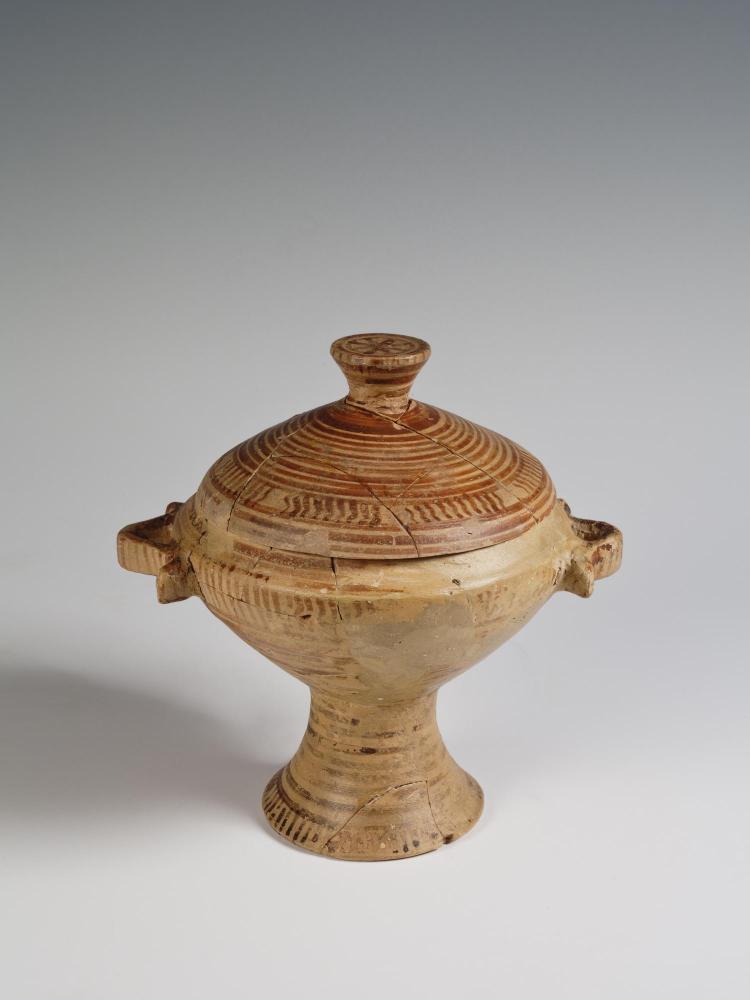Geometric Period Pottery and Its Decoration

The predominant form of art during the Geometric Period seems to have been painted pottery (3) and the vast majority of Geometric vases are found in cemeteries and other burial contexts in Greece. A well-known example of one such burial, the Tomb of the Rich Athenian Lady, included a variety of Geometric pottery. Archaeologists must base their interpretations on the material remains from these burials, as few written documents survive from this period (4). Our knowledge of this period, then, is restricted primarily to burial customs (5).
Vases performed several different functions in Geometric funerary practices. Some monumental amphorae and kraters acted as grave markers, as was the case with the so-called Dipylon amphora, which stands approximately five feet (1.55 meters) tall. Other vases, usually amphorae, acted as urns that held the ashes of cremated individuals, as was the case with the Tomb of the Rich Athenian Lady (above). A Boeotian amphora dated to c. 700 B.C.E. in the CU Art Museum's collection may be one such vessel. Still other types of vases were placed in graves as offerings to the deceased (7).
Both the shapes of vases in this period and their decoration derive from an earlier period called the Protogeometric period, which lasted from approximately 1,050-900 B.C.E. The Protogeometric style is characterized by vase shapes like the amphora, the krater, the oinochoe, and a range of cup shapes (8). Protogeometric decoration includes concentric circles and semicircles, checkerboard patterns, zig-zags, wavy lines, and lozenges in the form of triangles or diamonds. Minimal figural decoration adorns Protogeometric pottery; when it does occur it is, with few exceptions, in the form of animal motifs rather than depictions of human figures.
Vases from the Geometric Period tend to be of the same shapes as those of the Protogeometric, though they are usually taller and slimmer in form (9). The decoration on Geometric vases, however, suggests a substantial shift from the Protogeometric style, especially during the Middle and Late Geometric periods. In those later stages of the Geometric Period there appears to have been a growing interest in figural representation (10) and more variety in non-figural motifs, such as meanders and new forms of lozenges (11). These motifs usually form bands, or registers, of decoration and generally cover the vases from foot to rim.
One of the most significant changes in pottery decoration during this period is new interest in depicting the human form on vases, as on an Attic Geometric amphora at the University of Pennsylvania (12). Human figures on Geometric Period vases are depicted in a very stylized -- indeed, a geometric -- form. That is, they are conceptual rather than representational. In the earlier phases of the Geometric Period, human figures are shown as silhouettes and in a perspective that combines frontal and profile views, much like what we see in Egyptian figural representation. Additionally, figural decoration on surviving Geometric Period vases typically depict funerary scenes. Two well-known examples of this phenomenon are the Dipylon amphora, discussed above, which shows mourners surrounding a body lying in state in what is called the prothesis, and the Hirschfeld krater, also called the Dipylon krater, which shows a funeral procession, or ekphora. Both of these vases were found in a cemetery near the so-called Dipylon Gate in Athens. As the Geometric Period progressed, human figures were represented in more detail and a greater sense of realism (13), although geometric elements remained prevalent in the portrayal of the human form.
Some scholars have argued that Geometric pottery exhibits "primitive" (14) or under-developed artistic characteristics or that Geometric art is "not very complicated" (15). It is important to note, however, that these types of value judgments can undermine the greater concepts suggested in the images and the extent to which pottery as an art form had progressed by this period.
Footnotes
- Dates from William R. Biers, The Archaeology of Greece (Ithaca, NY: Cornell University Press, 1996): 110; John Boardman, Early Greek Vase Painting (New York and London: Thames & Hudson, 1998): 23; and John G. Pedley, Greek Art and Archaeology (Upper Saddle River, NJ : Prentice Hall, 2002): 118-24.
- Boardman, Early Greek Vase Painting: 23.
- J.N. Coldstream, Greek Geometric Pottery: A Survey of Ten Local Styles and Their Chronology (London: Methuen, 1968): 1.
- Coldstream, Greek Geometric Pottery: 332.
- J.N. Coldstream, "The Geometric style: birth of the picture," in eds. Tom Rasmussen and Nigel Spivey, Looking at Greek Vases (Cambridge: Cambridge University Press, 1991): 37-56.
- Pedley, Greek Art and Archaeology: 121; Biers, The Archaeology of Greece: 123; Boardman, Early Greek Vase Painting: 25-6.
- Emily Vermeule, Aspects of Death in Early Greek Art and Poetry (Berkeley, Los Angeles, and London: University of California Press, 1979).
- Pedley, Greek Art and Archaeology: 118.
- Biers, The Archaeology of Greece: 121.
- Boardman, Early Greek Vase Painting: 24.
- Pedley, Greek Art and Archaeology: 118.
- Biers, The Archaeology of Greece: 125.
- Biers, The Archaeology of Greece: 125.
- Bernhard Schweitzer, Greek Geometric Art (New York: Phaidon, 1971): 16.
- Anna Roes, Greek Geometric Art: Its Symbolism and Its Origin (Haarlem, Netherlands: H.D. Tjeenk Willink & Zoon, 1933): 9.

